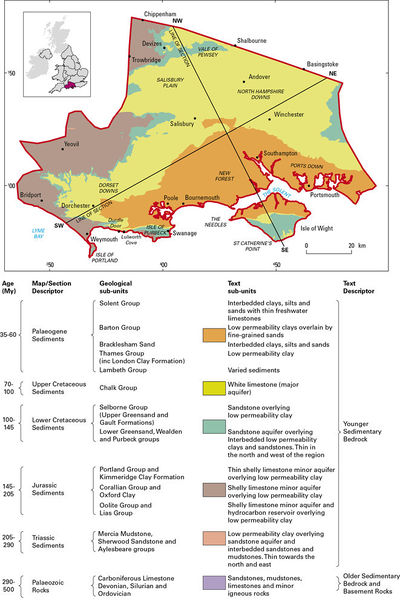Category:15. Hampshire Basin and adjoining areas

This account provides a broad perspective of the geology of the Hampshire Basin and adjoining areas, which covers the greater part of central southern England including the counties of Hampshire and the Isle of Wight together with significant parts of Wiltshire, Dorset and West Sussex. It is limited to the south by the coast of the English Channel. The region is principally rural with major urban areas concentrated on the southern coast including Bournemouth, Poole, Southampton and Portsmouth with smaller market towns inland including Dorchester, Yeovil, Salisbury, Devizes, Winchester, Andover and Basingstoke. Figure P902257 provides a geological sketch map of this region showing the rock types occurring in relation to the major towns and cities. Geologically the region forms the western part of a deep basin filled with sediments laid down in ancient seas. This account outlines the geology of the region to a depth of at least 1 km and summarises the current and historical use of the geological resources in the area.
The region is generally low lying with ridges, rising up to 300 m. The greater part of the region is drained into Poole Bay and the Solent by the Frome, Stour, Avon, Test and Itchen rivers. Geologically the region is well known at shallow depths due to the many quarries, shallow boreholes and coastal cliffs. The Chalk is particularly well known due to the large number of wells bored to depths of about 100 m into this major aquifer to provide drinking water.
The area is also traversed by a closely spaced network of exploration survey lines and many deep boreholes designed originally to investigate the oil and gas resources of the region. The regularly spaced boreholes provide valuable information about the geological layers at depth with more than 250 of these being over 150 m in depth and with a significant number reaching depths in the range 1500 to 3000 m. Geophysical seismic surveys provide information on the rocks between these boreholes by sending sound waves through the ground. Together these data provide a reasonably good understanding, to considerable depth, of the extent and variability of the rock units, and their structure. Understanding is improving all the time as a result of continued interest in oil and gas exploration, particularly in the south and west of the region. Concealed coal deposits are not known at depth within the region and consequently no deep mining has occurred.
Subcategories
This category has the following 2 subcategories, out of 2 total.
The number of included categories (C), pages (P) and files (F) is stated in brackets.